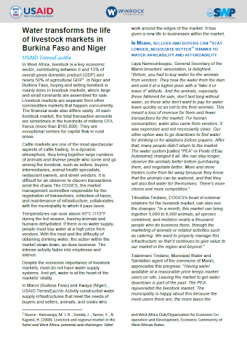In West Africa, livestock is a key economic sector, contributing between 8 percent and 15 percent of overall gross domestic product (GDP) and nearly 50 percent of agricultural GDP. In Niger and Burkina Faso, buying and selling livestock is mainly done in livestock markets, where large and small ruminants are assembled for sale. Livestock markets are separate from other commodities markets that happen concurrently. The financial scale also differs vastly. At each livestock market, the total transaction amounts are sometimes in the hundreds of millions CFA francs (more than $165,000).
Cattle bring together large numbers of animals and diverse people who come and go among the livestock, such as sellers, buyers, intermediaries, animal health specialists, restaurant owners, and street vendors. Meanwhile, temperatures can soar above 45°C/113°F during the hot season, leaving animals and humans dehydrated. If there is no water supply, people must buy water at a high price from vendors. With the heat and the difficulty of obtaining drinking water, the action within the market slows down, as does business. Despite the economic importance of livestock markets, most do not have water supply systems. And yet, water is at the heart of the markets’ vitality.
In Manni, Burkina Faso and Kwaya, Niger, the USAID TerresEauVie Activity constructed water supply infrastructures that meet the needs of buyers and sellers, animals, and cooks who work around the edges of the market. It has given a new life to businesses within the market.

Photo Credit: Abdel Nasser Moumouni, TerresEauVie

Photo Credit: Abdel Nasser Moumouni, TerresEauVie


